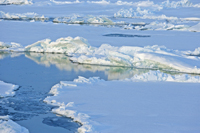Arctic, Antarctic: Poles Apart in Climate Response
May 2, 2008
While the Arctic and the Antarctic experience similar greenhouse gas levels and solar radiation, each region responds in a dramatically different way, especially in temperature and loss of sea ice, says an international team of scientists that includes a NOAA oceanographer. While the Arctic is warming, most of Antarctica is not, largely because of the ozone hole, but projections indicate that is likely to change.
“While some people would say this is a paradox, these different responses are mostly consistent with what we know about how the climate system works,” said James Overland, lead author and an oceanographer at NOAA’s Pacific Marine Environmental Laboratory in Seattle.
The findings, based on an October 2007 polar climate workshop, will be published in the May 6 issue of EOS, a publication of the American Geophysical Union. Co-authors are John Turner and Gareth Marshall of the British Antarctic Survey, Jennifer Francis of Rutgers University, Nathan Gillett of the University of East Anglia, and Michael Tjernstrom of Stockholm University.
Thirty scientists attended the Seattle workshop that looked at the Polar Regions from 1987 to 2007. The scientists concluded, based on new research since the 2007 Intergovernmental Panel on Climate Change Report, that a combination of factors is responsible for the recent dramatic sea ice loss in the Arctic as well as masking some of the effects in the Antarctic.
Temperature
- Arctic: Experienced seasonal temperatures that at times were more than four degrees Fahrenheit
warmer than usual.
- Antarctic: For most of the Antarctic, temperatures were not unusual, except on the Antarctic Peninsula, a finger of land and ice about 1,000 miles south of the tip of South America, which had the largest increase in temperatures of any location in the Southern Hemisphere. Temperatures warmed by three degrees Fahrenheit. Warming temperatures and exposure to ocean waves were cited by the National Snow and Ice Data Center as the cause of the collapse of a 160-square-mile segment of the Wilkins Ice Shelf on the Antarctic Peninsula, which began collapsing in late February.
Sea Ice
- Arctic: Summer sea ice loss was greater and declining more rapidly than climate models projected.
- Antarctic: The amount and stability of the sea ice was not unusual.
Human-Influenced Change
- Arctic: There are multiple causes for change.
“In the Arctic, there is a combination of factors, such as warming of the air because of more greenhouse gases, an unusual wind pattern, and warming of the ocean water in regions with reduced sea ice,” said Overland.
- Antarctic: Story is clearer.
Gillett, a climate dynamics scientist, said, “In the Antarctic, the changes in winds and temperatures are consistent with how we would expect them to respond to increased greenhouse gases and depletion of stratospheric ozone.”
The depletion of ozone has strengthened the atmospheric circulation, called the Southern Annual Mode, or SAM. As the ozone hole recovers, the winds that currently whiz around Antarctica and block air masses from crossing into the continent’s interior would weaken, and Antarctica would no longer be so isolated from global warming patterns.
The Future
- Arctic: Sea ice losses will continue. The study says that a combination of factors has sent the Arctic into a new state of sea ice loss, which is occurring much earlier than projected by climate models subject to greenhouse gases alone.
“Additional warming of the ocean and an overall thinning of the sea ice makes it difficult for the Arctic to now return to earlier conditions,” says Overland.
- Antarctic: Scientists project that the ozone hole should fully recover by 2070.
“As the ozone hole recovers, we expect that warming will appear on the central plateau of Antarctica and we will see a reduction in sea ice area,” said Turner.

